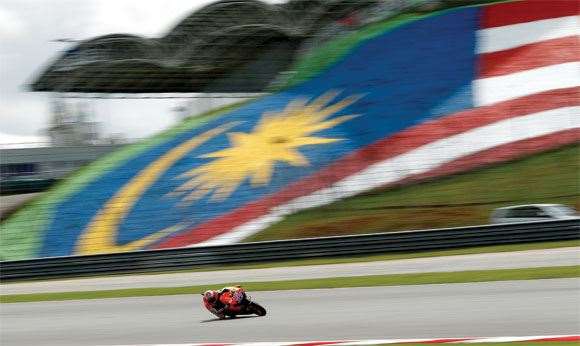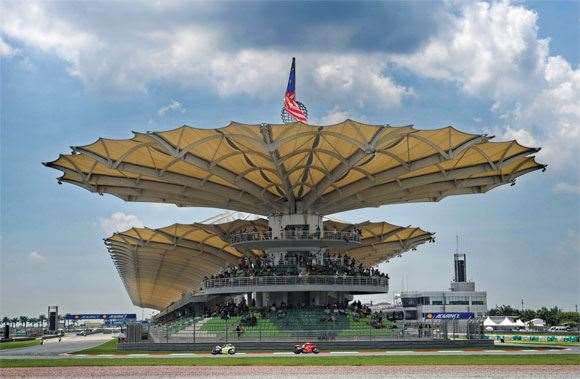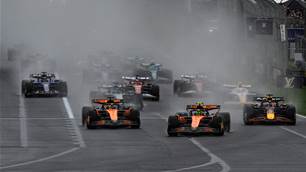You’ll struggle to find better bike racing than that at Malaysia’s Sepang Circuit. With full respect to the late Marco Simoncelli, of course.
You’ll struggle to find better bike racing than that at Malaysia’s Sepang Circuit. With full respect to the late Marco Simoncelli, of course.
 photos by, Getty Images
photos by, Getty ImagesI know all this because last month I was at Sepang. No doubt it will now be a fading memory that the race only lasted a lap and a half. Marco Simoncelli lost the underside of his bike and slid to the tarmac on turn 11 of the second lap, catching the front wheel of Colin Edwards’ Yamaha in the middle of his back and the wheel of Valentino Rossi’s Ducati at the base of his skull, the force of the contact tearing the helmet from his head and knocking the life from his body. Turn 11 is an innocuous right-hander that sits at the peak of a gentle rise midway along the southern half of the circuit. The entire southern section of the Mall Grandstand – a 700m-long bank of bucket seats shaded by a fluted sail – looks straight onto the rise and fall of that turn. No doubt most of the 15,000 people who filled the stand that afternoon had their eyes fixed on the 24-year-old rider from the Italian beach town of Cattolica when he died ... No doubt some of them cheered at the thrilling sight of a man hitting tarmac at 200km/h.
I didn’t see the crash with my own eyes. I was standing trackside at turn 1 and was watching the big screen when it happened. But as it all played out – as the race was red-flagged, then cancelled altogether – an unpleasant feeling began to take hold. I felt guilty, soiled. I felt as if I’d been a party to a crime. Because, hell, I’d gone to Sepang hoping to see crashes. I’d travelled all the way to Kuala Lumpur hoping to see riders bucked from their machines and shot tumbling across acres of gravel, to see bikes skidding across the tarmac in an incandescence of sparks. And, judging by the great noise that rose from the 70,000-strong crowd every time a rider lost his bike, I wasn’t the only one.
Of course, crashes weren’t the sole reason I’d come to watch this grand prix. I’d always wanted to spend a weekend at a track watching a sport that I’d heard was magical live: all the din and fury of F1 gilded by daring passes and spiteful elbows and grazed knees. And the Sepang International Circuit is a perfect stage to open a MotoGP education. Considered by many to be the finest work of legendary track designer Hermann Tilke, this circuit ‒ surrounded by endless tracts of date palms and swathed in a haze of broiling tropical heat ‒ is a beautiful place to watch motorsport. With its two monumental straights separated by a single hairpin, its collection of turns and subtle elevation shifts, it’s an intricately sculpted track that produces cracking races.
I spent most of the race day nestled behind the b barriers on a scorched patch of grass that sits in the crook of the first turn. Open to an ambulance crew and a few lucky journalists, there can be few better places in the world to watch motorsport. Coming off the track’s final turn, a nasty hairpin, the riders find a vast kilometre-long home straight stretching before them. With their throttles wide open and their engines emitting a fine scream, they top 310km/h before turn 1, a sinuous S-bend, hoves into view. Two hundred metres from the turn, they sit tall in the saddle and hit the brakes, working weight onto their front wheel, spreading the tyre flat on the tarmac. A hundred metres from the turn, they push furiously against their handles as their bikes leave dark rubber on the track. By the time they flatten against their machine and lean into that first right-hander, their speed has dropped to 90km/h and their bikes are making tortured, punching noises. They’ve scarcely rounded that bend before they drop into first and pull their machines into a looping left-hander, the track falling sharply beneath them, the bikes making a truly aggrieved hissing noise. Standing at the barriers of that first turn, it all happens so close, I could’ve reached out with a broom handle and tapped the riders on the helmet as they tore past. And when the crashes come, as they invariably do on a corner as demanding as that, they make for spectacular viewing. One unfortunate in the 125cc race lost his back wheel and was thrown off the topside of his bike. He arced slowly through the air, his arms and legs spreadeagled, before disappearing in a spray of sparks and gravel. The hoard packed into the K Grandstand roared their approval and I grinned like an idiot as the stewards in their orange jumpsuits swarmed onto the gravel and carted the tiny rider away on a stretcher. An hour later, in the penultimate lap of the Moto2 race, the Spaniard Axel Pons shot off his bike as he left turn 1 and tumbled away down the slope. The red flags came out as the medics broke a run getting him to the waiting ambulance. I followed them and gawked open-mouthed as the 20-year-old Barcelonan, his braced face white with shock, his mouth sagging open, was slid into the ambulance. As it drove off his girlfriend arrived on a scooter. She looked about with stricken eyes, her hand over her mouth. An hour after that, of course, Simoncelli went down.
 photos by, Getty Images
photos by, Getty ImagesFor a time, no one knew what to make of the scene. A silver-haired New Zealand journo shook his head. “It can’t be good,” he muttered. “It’s never good when they get hit by other bikes like that.” Rumours washed back and forth amongst the journos. One moment Simoncelli was conscious in the medical centre, the next he’d already been declared dead. The sun poked through the ceiling of thunderheads and the heat turned torturous. Up in the K Grandstand there were eruptions of noise as a lone bloke with an Australian fan taunted the hoard of Rossi fans. The big screen showed the riders sitting in their pits, industrial-sized fans turned on their faces. As the minutes ticked by their expressions darkened. The chanting in the K Grandstand grew more frenzied. Bottles and cans tossed from the Mall Grandstand began to rain on the home straight. The riders’ faces grew darker and darker. Most of them had taken their leathers off. The rain of rubbish on the track grew heavier.
There was no announcement ‒ the big screen simply showed archive footage of Simoncelli sweeping around a corner with a tagline reading that he’d “succumbed to his injuries at 4:56pm”. The bottles stopped falling on the straight as the sun disappeared behind the clouds. I’ve never seen 70,000 people leave a sporting stadium so quietly. They filed out in neat rows, their heads down. No one spoke. Outside, the highway back to Kuala Lumpur was in gridlock. Inside the cars no one was talking. I suspect most of them felt as guilty as I did.
The next day I went back to Sepang for a tour of the circuit with a group of journalists. The tents were still up, the empty stands covered in rubbish, the pit lane filled with oversize cargo freight boxes. We sat on an air-conditioned bus as it made a leisurely lap of the track. At turn 11 it slowed, then stopped. Two small posies of flowers had been laid on the track. They were already wilting in the equatorial heat. Beneath them, on the tarmac, three sets of tyre marks darkened, then hooked, then disappeared altogether.
‒ Aaron Scott
Related Articles

Gallery: 2025 Australian Grand Prix

How to tell you've gone too far as a sports fan.













